Views:
-
Eirieza Dark green Echinopsis, spherical in juveniles and short-cylindrical in adult specimens.
Height 20-22 cm, diameter about 15 cm.Areoles are white-yellow, rounded. The spines are long. The flowers are elongated, white-pink.
- Chilean Arboreal, branches at the base. The stem is cylindrical, elongated. Ribs with pronounced tubercles, low. Pale yellow, one to two centimeters long. The central thorn is 4-7 cm. The flowers are large, about 14 centimeters in length.
- Pampana Stem spherical, 5-7 centimeters in diameter. The spines are curved, up to 5 centimeters long. The flowers are red.
-
Awl The height of the stem is 5-6 centimeters. About 14 ribs.
Areoles and spines are white. Flowers are fiery red, erect.
-
Klinger's stem is spherical at the top, cylindrical at the base. Spines are long, grayish, located on light pubescent areoles.
Flowers with multi-tiered petals, snow-white with dark tips.
- Dumat The stem is undersized, rounded, with pronounced ribs. The spines are small. The flowers are lilac-white.
- Sharp-edged Spherical, somewhat elongated stem, diameter 20-25 cm, length 15 cm. Covered with pointed ribs with large areoles. The flowers are purple-red. It blooms at night, in May-June.
- Mammillose kermezin An exquisite form of Echinopsis cactus, single stem, about 30 centimeters. Areoles are rounded with yellow subulate spines. Pink flowers growing in tiers.
- Tubular Green, first spherical, then cylindrical stem. The spines are brown, black at the tips. It blooms with large, funnel-shaped, white flowers on a twenty-centimeter stalk.
- Ancystrophe Green small stem in the form of a flattened ball. Covered with pronounced tubercles and hooked spines. The flowers are white.
-
Subdenudata Differs from other species in the absence of thorns. Spherical flattened stem 20 centimeters high and 10 centimeters in diameter.
Flowers are 10 cm. Blooms at a young age.
-
Golden Stem spherical at the beginning of growth and cylindrical in the adult. Pronounced ribs covered with centimeter spines.
The flower is yellow-orange. Withstands light frosts.
- Bakeberg Round-cylindrical stems, height up to 7 centimeters. The flowers are bright pink.
- Bridges grows in groups of 4 to 6 trunks. Tall stems, about 40 centimeters, 10-13 centimeters in diameter. The flowers are white.
- Hamecerus Forms numerous stems hanging from the edge of the pot. It blooms in spring with bright orange flowers. Frost resistant.
- Bright green echinopsis Globular stem about 9 centimeters in diameter. Rare radial, numerous central needles.
- Coquimban Cylindrical, elongated stem. In nature, it grows up to one meter. Forms dense thickets.
Reproduction methods

Echinopsis in indoor conditions can be propagated in two ways: by seeds and daughter processes.
Growing from seeds
Immediately before sowing, the seed must be poured with warm water for a while so that it swells. Take a small container and fill it with a moist soil mixture of charcoal, leafy soil, and river sand (1: 1: 1). Sow the prepared seeds and cover the container with foil or glass. Remove crops in a well-lit place where the air temperature will be 19-20 degrees. Crops need regular ventilation, which is carried out every day, as well as timely moistening of the substrate. Remove condensation from the shelter if necessary. Immediately after the first seedlings appear, remove the shelter from the container. When the seedlings grow up and get stronger, they should be cut into individual, not very large cups.
How do I get seeds? Flowering, pollination of Echinopsis (Echinopsis hybr.)
Reproduction by children
Also, this cactus can be easily propagated by daughter shoots that grow directly on the parent bush. It happens that a lot of children grow up on one adult echinopsis. After the baby is separated, it should be left in the open air for a while to dry. Only after that is it planted in a separate pot. But remember that bushes propagated in this way are less likely to bloom.
Rejuvenating the old bush
If the cactus is already very old, then it is recommended to rejuvenate it, and this procedure is combined with vegetative reproduction. To do this, very carefully cut off the top of the bush and leave it outdoors for half a month so that it can dry well. Only then is it planted in moistened sand for rooting. The part of the bush that remains in the pot after pruning will also continue to grow, and a large number of young shoots will appear on it.
Echinopsis - reproduction
The Echinopsis cactus does not reproduce vegetatively, although there is such a widespread opinion. In order to prevent the degeneration of the flower, it must be propagated by seeds. Although the first method is the easiest and everyone uses it, self-sterile echinopsis "forgets" over time how to bloom. If you want to get a blooming and beautiful specimen, stock up on seeds and patience. With seed reproduction, flowering is expected for a long time. Echinopsis fruits are egg-shaped and set after flowering. Black, smooth, shiny seeds ripen in them.
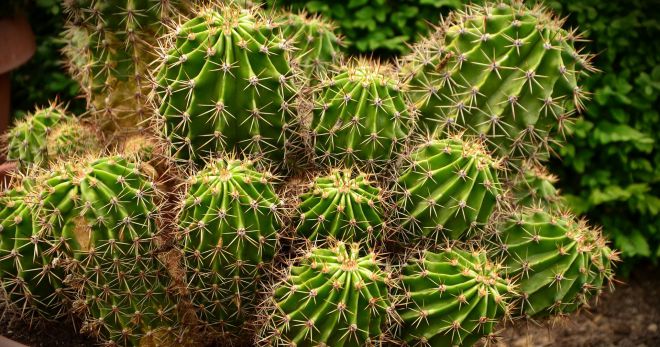
For germination, the seeds are soaked in water at room temperature, then sown in a regular substrate for succulents. Coated with glass and at room temperature, the seeds germinate quickly. The earth is moistened as it dries. When shoots appear, they are not covered, allowing them to grow. The grown echinopsis are seated in separate flowerpots. This type of cactus is solitary.
Echinopsis are cross-pollinated. To obtain seeds, you need two cacti with different genetics. Fruits will not grow if you pollinate cacti grown from the same mother plant. Some growers successfully pollinate Echinopsis with pollen from other cactus species that bloom at the same time. Sometimes they collect pollen from a flowering plant and store it in the refrigerator for up to 2 months, after which it loses its ability to pollinate. The fruit ovary is not immediately visible, only as the flower tube dries up.
Echinopsis babies
When propagated by shoots, the plant grows identical in appearance to the mother. For reproduction, children are cut with a sterile instrument, the cut is allowed to dry and then planted in a substrate. If the new plant is already with seeking roots, then it is planted immediately. The soil for the plant should be light. First, drainage is applied to the flowerpot, and then a mixture is poured, which includes humus, sand, peat and leafy earth. You can just use sand and earth. The Echinopsis flower requires the removal of children, if they have grown strongly, for greater flowering of the mother plant.
Often cacti become inhabitants of offices and settle near computers, so even busy people can grow such a flower. Echinopsis cactus is difficult to ruin, but certain care skills are needed to make it bloom repeatedly and densely. This plant needs to create conditions close to its native hot climate: with sufficient watering, plenty of light and fresh air.
3. Varieties:
3.1. Echinopsis subdenudata - Echinopsis subdenudata
Small globular cacti with dull, green, slightly flattened stems. With age, numerous lateral processes may appear at the base of the stems. The ribs are vertical, deep, bearing sparsely located woolly areoles. The areoles contain very short, sharp spines.During the flowering period, tall flower tubes appear on the side of the stem, bearing large, single, white, less often pink flowers with numerous long petals at the top. Each cactus can have several peduncles. The flowers open at night and have a pleasant aroma.

3.2. Echinopsis sharp-edged - Echinopsis oxigona
Rounded green cacti, forming large clusters with age. Sometimes the stems can take on a cylindrical shape. Shades of stems are varied and include green, bluish green, dark green. The ribs are numerous, deep, vertical, with pubescent halos. Each areola has several long, strong, light, straight spines. The flowers are funnel-shaped, on long flower tubes appearing on the side of the stems. An interesting feature of plants is that the inner petals of the flowers are often white, while the outer petals are lilac or pinkish. The flowers open at night and have a very pleasant aroma.
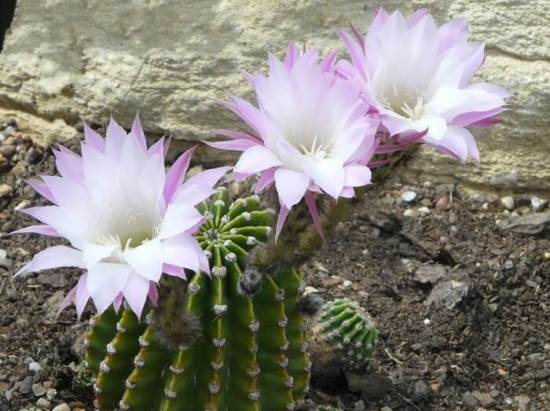
3.3. Echinopsis tubotvetny - Echinopsis tubiflora
Low spherical cacti, overgrowing over time with numerous lateral processes. Stems are green, have vertical, deep ribs, reach a diameter of 10 - 16 cm. Areoles are woolly, sometimes they form long, sharp, straight spines or may not have spines at all. Numerous flower tubes appear in the summer months and bear single, large, funnel-shaped flowers up to 15 cm in diameter at the tops. Flower shades vary from white to salmon, pink, lilac. Flowers open at night.
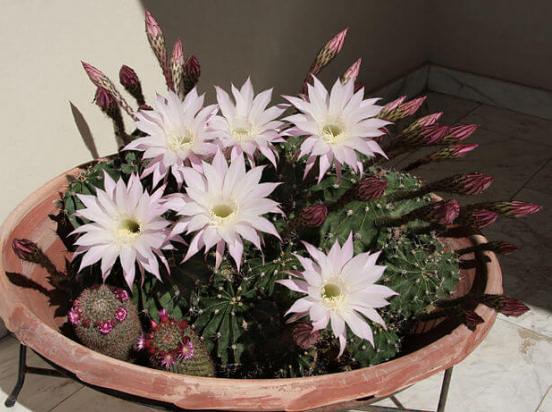
3.4. Echinopsis Erye - Echinopsis eyriesii
Spherical or club-shaped cacti 15 to 30 cm high. With age, plant stems can become cylindrical, 12 to 15 cm in diameter. The stems have deep, vertical ribs with sparse areoles. Areoas are slightly pubescent and have short, straight spines. The flowers are very large, funnel-shaped, white or lilac, open at night and reach a diameter of 10 cm, appear on very long flower tubes. Each stem is capable of forming several flowers at once.
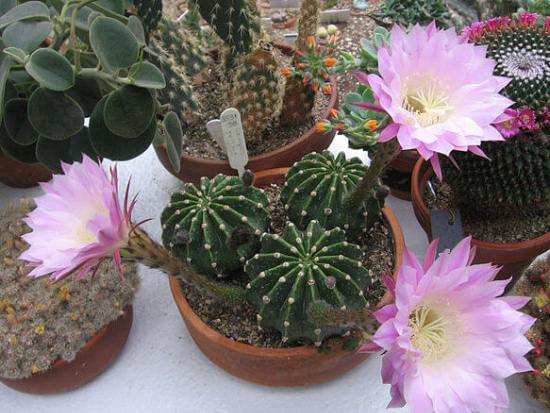
3.5. Echinopsis golden - Echinopsis aurea
Small spherical or cylindrical cacti with dark green stems reaching a height of 5 to 10 cm. Numerous, vertical, deep ribs bear closely spaced halos with long, sharp, light spines. During the flowering period, tall, slightly curved flower tubes 4 to 6 cm long appear on the side of the stems. The flowers are yellow, with numerous thin, silky petals, reaching a diameter of 5 cm. Cacti with white, pink or red flowers are much less common.
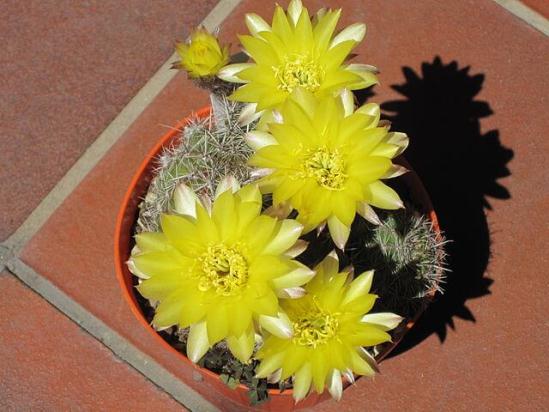
3.6. Echinopsis white-flowered - Echinopsis leucantha
Spherical or cylindrical cacti with green, dull stems up to 40 cm high. As they grow older, the plants can form numerous lateral processes at the base of the stems. Ribs vertical, deep, bearing numerous areoles with long, light, slightly curved spines. During the summer months, the plant produces erect, smooth, tall flower tubes with large, white, funnel-shaped flowers on top. Flowers open at night.
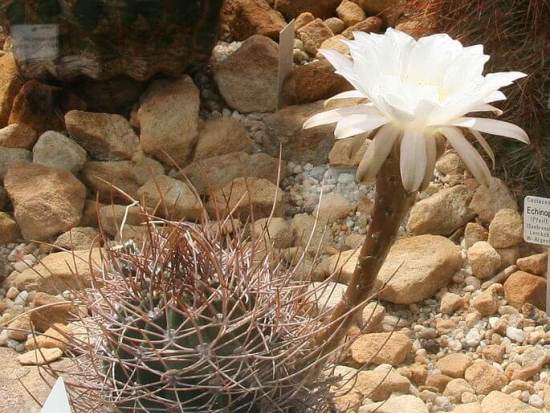
You may also be interested in:
Cereus
Mammillaria
Astrophytum
Echinocactus
Caring for a cactus at home
Cacti in indoor floriculture are a fairly common culture. Almost every home has a computer, near it is the main absorber of harmful radiation - a cactus. However, many people forget that it needs to be looked after. When purchasing a cactus, you need to study the conditions of its maintenance so that it looks healthy and beautiful. Group placement of cacti is recommended. When they develop in such a group colony, their uniform and harmonious growth is observed.
Cactus in apartment design
To successfully grow cacti in the house, it should be borne in mind that factors such as illumination, temperature, air humidity, soil composition and watering affect their development. The season makes certain adjustments to all of these parameters. The growing season for a cactus lasts from March to September. Winter rest will be the months from October to February.
Temperature
The vital activity of a cactus depends on the temperature regime. During the growing season, the cactus is not affected by small temperature fluctuations from 26 to 28 ° C. But, if the ambient temperature becomes more than 30 ° C, the metabolic processes occurring in the plant begin to slow down. The cactus falls into a state of stagnation, stops growing and sheds its buds.
During the winter period, for most cacti, the temperature range is from +10 to + 15C.
Each type of cactus will have a different one:
- Wintering of Mammillaria and Echinopsis goes well at a temperature of + 12-15 ° С.
- Rebucia, Atrophytum and Echinocerius winter at temperatures ranging from +8 to + 10 ° C.
- Lower temperatures from 0 to + 5 ° С tolerate Neoessia and Ecobaria well.
As cactusists note, at such temperatures during the winter period, an important stage for the plant occurs - the laying of buds. In comfortable conditions, succulents spend all their strength on growth.
Note! If the cactus does not bloom, you need to put it on a warmed balcony for the winter, thereby creating discomfort, which means that it is possible to book buds
Lighting
Bright diffused light is the best lighting for almost all representatives of the Cactus species. If the illumination is insufficient, this leads to stretching of the plant, regardless of its shape. The color of the cactus becomes pale, and there is no need to dream that such a cactus will bloom.
With an excess of light, the plant gets a "tan" on the side facing the sun. Therefore, the cactus pot should not be located close to the window pane. The window during the bright sun should be shaded in all possible ways. Moving the cactus pot is not recommended. It's stressful for him. As a result, all buds and flowers can be shed.
Humidity
In a room with cacti, it is desirable to maintain a moderate humidity. They don't like hot stuffy air. Ventilation is required, but no drafts. Florists recommend spraying the plant in the morning and evening hours. It is better to use a fine spray, which creates a fog over the cacti, reminiscent of the conditions of life in nature.
Watering
The opinion that succulents do not need systematic watering is erroneous. Excess watering is more destructive for them than dry soil. In order for a cactus to bloom in the summer, it does not need abundant watering, it is enough to water it once a week with water that has been settled for several days. The earth should not be flooded with water, only a lump of earth is moistened. In the fall, the interval between watering increases. Only completely dry soil should be watered.
Watering cacti
During the dormant period, the cactus stops absorbing moisture from the soil, so excess moisture can lead to root rot. The land must be completely dry in winter. Light hydration is done once a month.
As soon as daylight hours begin to increase, the cactus needs to be awakened from hibernation by spraying it with hot water, the temperature of which is not more than 50 ° C. After a week, the cactus needs to be watered abundantly. After this procedure, switch to summer watering regime.
Houseplants, including cacti, are properly cared for and thrive and flourish. Illiterate care, in particular, watering with cold water, dry air, improper temperature conditions and lack of light, will become the main cause of the disease. We must not forget to periodically inspect the cacti.
Bloom
Any indoor flower plunges into a dormant period, when it needs to rest and gain strength.This also applies to cacti, which can be made to bloom if you provide them with quality care and observe the temperature regime. Echinopsis can produce flowers in large quantities, but for this the grower will have to try
Bright sunlight, regular watering and warm temperatures during the growing season are the first things to look out for.
The rest period often occurs in winter, at this time you just need to remove the cactus in a cooler place, reduce watering to a minimum. Plants grown from seeds should bloom by this time every year. However, Echinopsis does not always want to demonstrate its beauty indoors, and often the reason is numerous mistakes on the part of a person. You cannot repot the cactus when it has picked up the buds. A change in capacity and trauma to the root system, although it is small, lead to the fact that the flower will simply throw off the buds, since it needs strength to recover. The procedure is carried out after flowering or two months before.
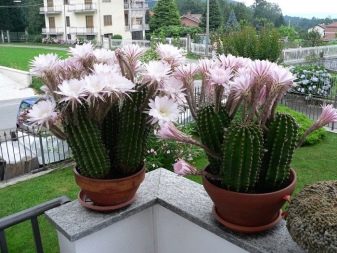

Features of echinopsis

While Echinopsis is young, it has a spherical shape, but over time, its stem becomes more elongated and columnar. Glossy, smooth, symmetrical, sharp-ribbed stem, it can be colored in various shades from dark green to greenish. The strong root system is located horizontally and fairly close to the surface of the substrate. Areoles carrying hard spines are equidistant from each other. The length of the spines depends on the species; they are both short and can reach a length of several centimeters. During flowering, funnel-shaped flowers are formed on the cactus, the diameter of which is about 15 centimeters, and the length is up to 30 centimeters. They include many petals arranged in 7 rows, as well as a tube, on the surface of which there is pubescence. The flowers grow from the areoles in the middle of the stem. Corollas can vary in color from purple-pink to white. The number of flowers formed is influenced by both the health of the bush and how old it is: about 25 flowers can form on an old healthy plant at the same time. However, the lifespan of each flower is short and is 1-3 days (depending on the temperature in the room). Inside the ovoid fruits are glossy smooth black seeds.
Echinopsis subdenudatus. Echinopsis cactus care.
Plant varieties
Sharp-edged
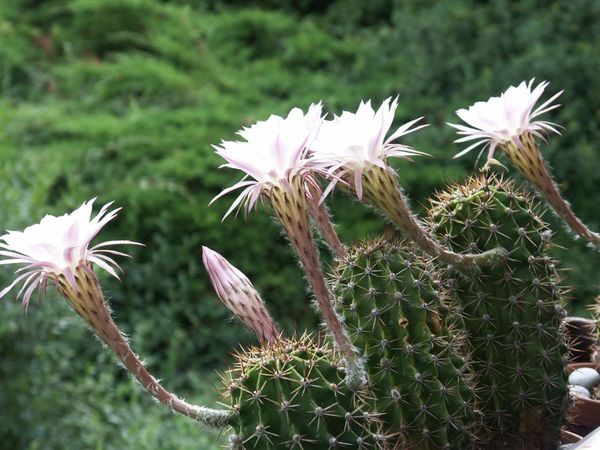
Representatives of this variety have a spherical stem up to 20 cm in diameter, which stretches during the growth process. The plant has 15 sharp ribs, on which spines are located. In young plants, the needles are yellow, and with age they become almost black. The flowers have pinkish-white petals, up to 10 cm in diameter.
Echinopsis eirieza
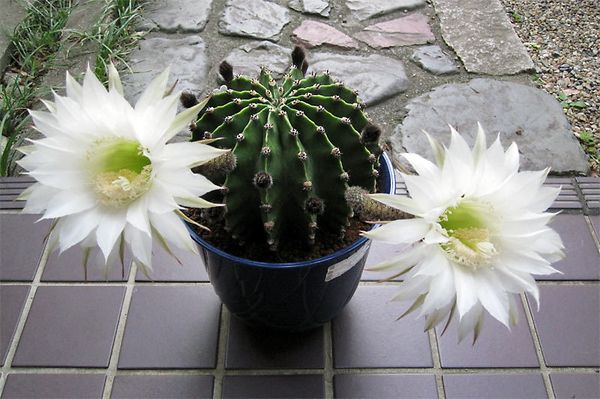
This type of cactus forms many lateral babies. The plant has up to 18 ribs covered with tiny spines. The flowers are pale pink. Wide petals, growing in several rows, are slightly pointed at the ends.
White-flowered
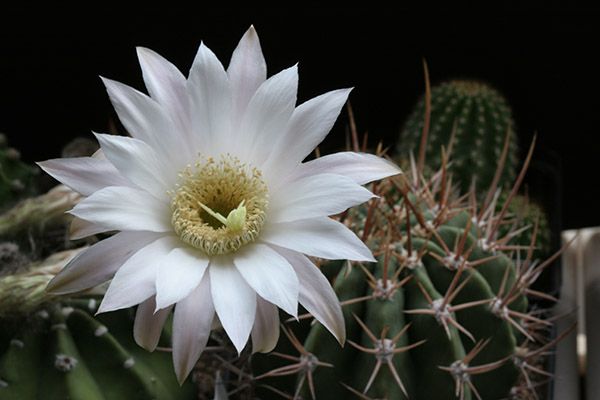
From the name it is clear that the flower petals of this succulent are painted white. The dark green stem has wavy edges. The plant resembles a column in shape, which reaches a height of 30–35 cm and a diameter of 10–12 cm.
Mamylose
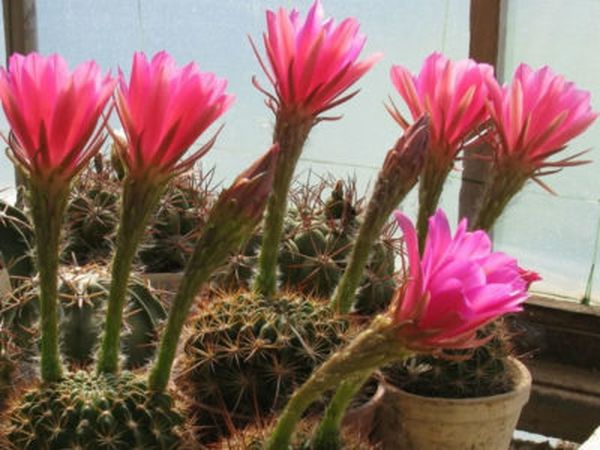
This variety retains its rounded shape as it matures. The ribs have characteristic tubercles, from which spines grow up to 1 cm long. Wide pink petals on the flowers grow in two rows.
Golden

This type of cactus is the smallest. In an adult state, it grows up to 10 cm. At first, this baby looks like a ball, and then as it grows, it stretches, and the top becomes flattened. There are thorns in the areoles and on the ribs of the cactus.They look pretty in a brown-gold color, but they are still thorny to the touch.
In total, the succulent contains 15 ribs. During flowering, large bright yellow flowers appear in comparison with the growth of the cactus itself.
Hook-nosed
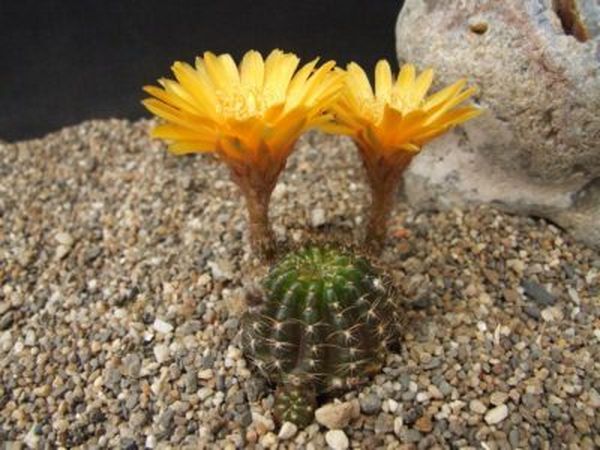
Echinopsis hooknose, also from the category of mini-cacti, looks like a ball with a flattened crown, which is covered with 20 ribs. They are decorated with areoles with light brown spines. In each individual areola, up to 10 spines can be located, which stick out in different directions, the largest - the central one (2 cm) - looks like a curved hook.
Subdenudata or semi-naked
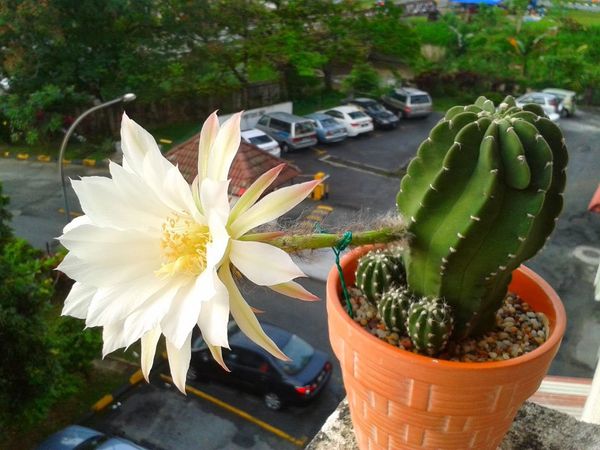
This species is practically devoid of threatening thorns. On a flattened fleshy ball, you can count 12 sharp ribs. The fluffy areola contains 1–2 small spines. During flowering, this cute succulent plant adorns itself with large snow-white flowers. It is good as a rootstock for grafting on other plants.
Hybrid

Echinopsis has many forms that bloom in completely different ways. This fact prompted scientists to think about crossing different species in order to get new varieties with unusual, original flowering, varied shape and color.
Hybrids differ from their "congeners":
- grow very slowly;
- practically have no children;
- bloom profusely.
Also, the plants have an original color, they are terry and lush flower heads.
Echinopsis pests and diseases
Echinopsis diseases and their treatment
Echinopsis are extremely resistant to any diseases and pests. The most serious problem for them is waterlogging of the substrate, from which rot develops on cacti. Cut out the decaying areas with a sharp, sterile instrument and treat the wounds with a fungicide solution. But the most important thing that needs to be done so that the cacti do not get sick is to observe the scanty watering regime during the growing season and forget about watering while the plant is at rest.
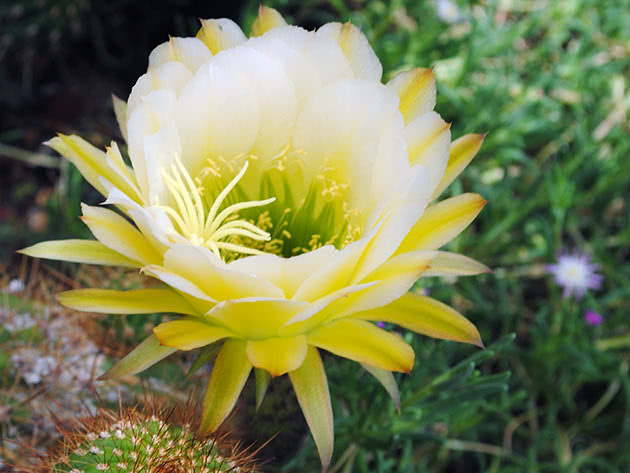 In the photo: Growing Echinopsis in an apartment
In the photo: Growing Echinopsis in an apartment
Echinopsis pests and the fight against them
Watering Echinopsis often - the plant will rot, rarely watering - a spider mite can settle on it, which prefers to live in an environment with low humidity. Spider mites feed on the cell sap of plants, making punctures in their tissues. You can guess the presence of ticks on the plant by the thin cobwebs. You can get rid of a small amount of pests by washing the cactus with soapy water, but before the procedure, you need to protect the substrate from soap getting into it. If this measure does not work, you will have to treat the plant with acaricides, for example, Aktellik or Fitoverm. If you have the choice, opt for a less toxic product and spray outdoors.
Conditions for a cactus
A suitable setting in the room is the key to the timely and long flowering of Echinopsis.
Lighting needs
Echinopsis loves sunlight. South orientation of the window and direct sunlight at any time of the day will not harm it. The plant also feels fine near the east or west window. But on the north side, it probably will not bloom.
Soil composition and pot requirements
Due to the peculiarity of the root system, the Echinopsis pot needs a shallow and moderately wide one. The soil should correspond as much as possible to the natural soil for the plant:
- loose, well aerated structure;
- pH level - neutral or close to it;
- the nutritional level is above average.
Important! Healthy soil composition in a cactus pot: a mixture of turf and leafy soil, coarse sand with a small amount of fine stone chips or gravel and charcoal
Temperature and humidity requirements
In the cultivation of echinopsis at home, experts distinguish two periods:
- Summer. The range of temperature indicators: + 22 ... + 27 ° C.
- Winter. The recommended heat level at this time is about +9 ° C.The cactus is brought out to the balcony for successful flowering in spring.
It's important to know! Lighting requirements remain unchanged at any time of the year. In terms of humidity, Echinopsis is completely undemanding.
The level usual for room conditions will suit him.
In terms of humidity, Echinopsis is completely undemanding. The level usual for room conditions will suit him.


